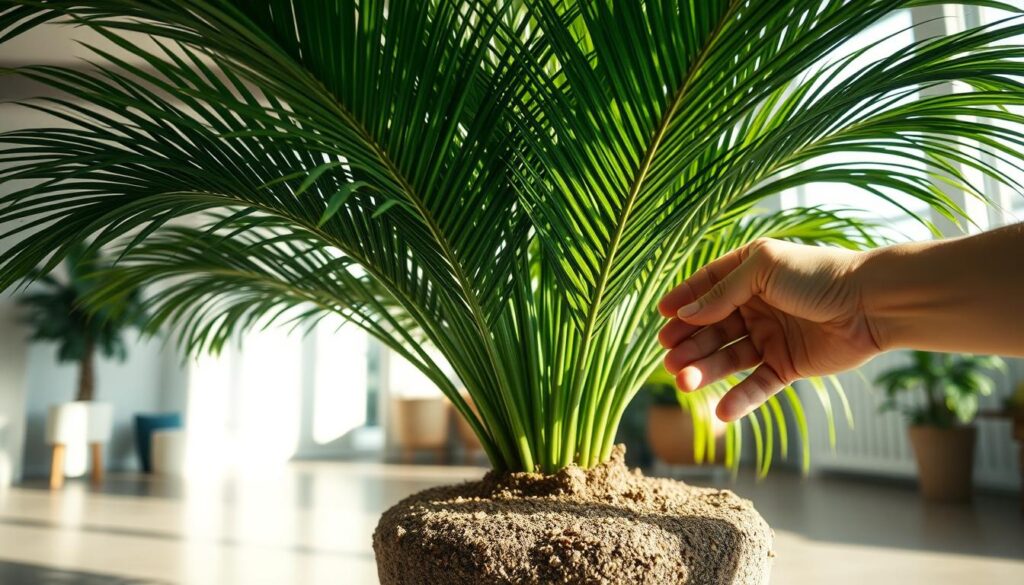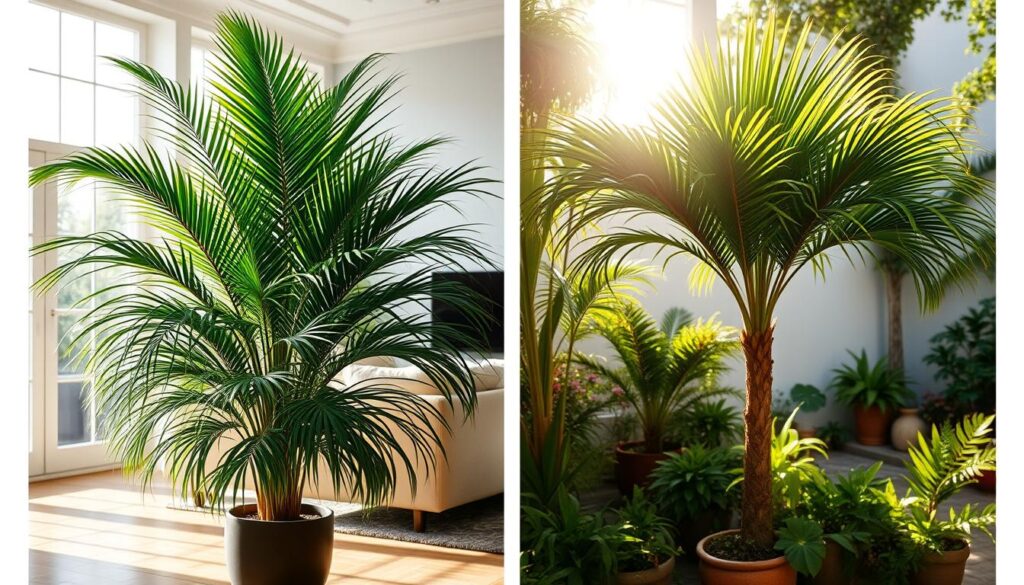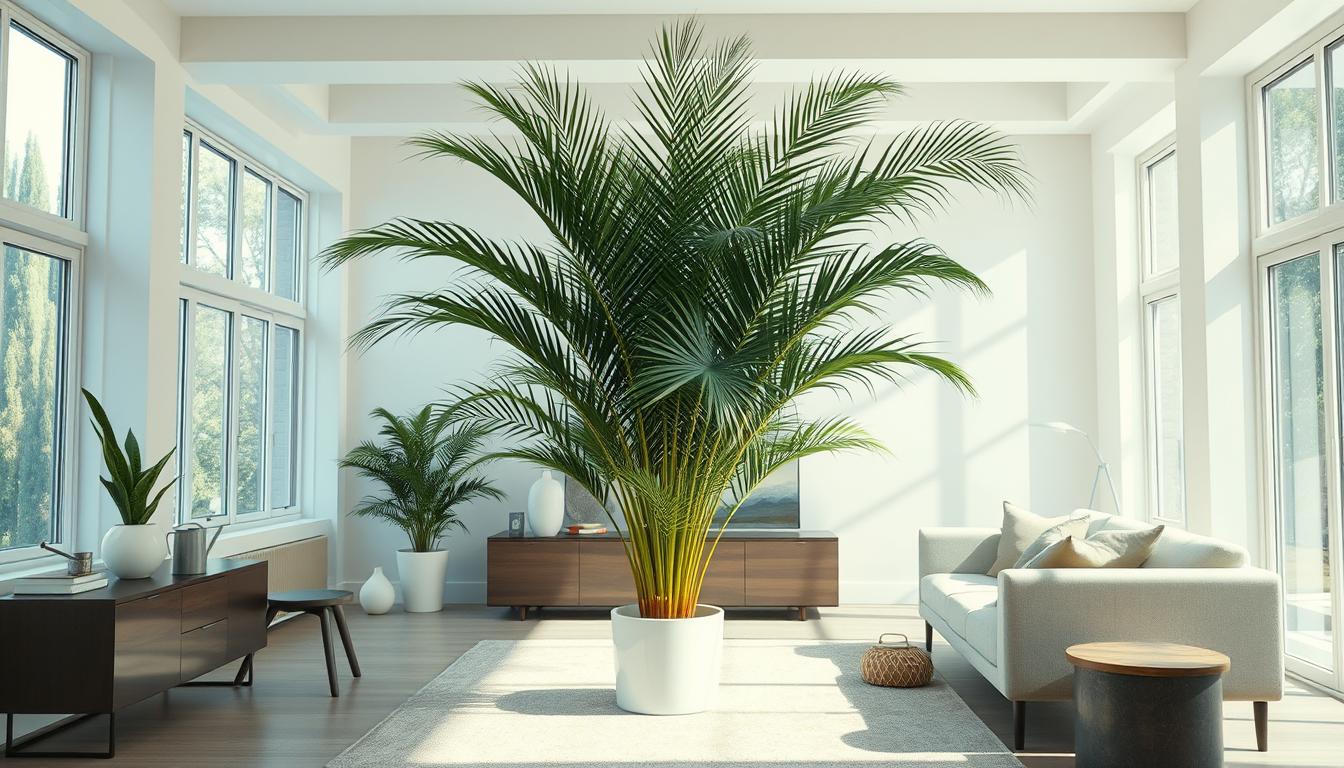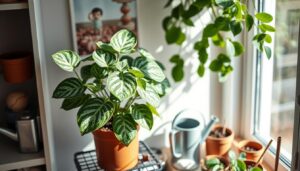Why do people love the Kentia Palm for their homes? It’s great for low light and grows slowly. This makes it a beautiful and easy-to-care-for houseplant that can get quite tall. For more tips on caring for your plants, check out Kentia Palm care tips.
The Kentia Palm is special because it comes from Lord Howe Island in Australia. It’s loved for being easy to care for. With the right care, you can have this tropical beauty in your home.
Understanding the Kentia Palm and Its Characteristics
The Kentia Palm is a favorite for indoor decor. It has long, arching fronds and a slender trunk. It comes from Lord Howe Island in Australia.
It’s been popular for centuries, especially in fancy places. It’s easy to care for, making it perfect for all gardeners.
Some important Kentia Palm characteristics are its love for low light and wide temperature range. It was a symbol of wealth in the 19th century.
Here are some key facts about Kentia Palms:
- They can live for up to 50 years when properly cared for
- They prefer temperatures between 65°F to 90°F (18°C to 32°C)
- They require watering approximately once a week during the growing season
Knowing about the Kentia Palm characteristics and Kentia Palm origins helps us appreciate this plant. It’s a great pick for anyone wanting to bring greenery into their home.
| Kentia Palm Care | Recommendation |
|---|---|
| Watering | Once a week during growing season |
| Temperature | 65°F to 90°F (18°C to 32°C) |
| Fertilization | Balanced liquid fertilizer diluted to half strength |
The Perfect Location for Your Kentia Palm
Choosing the right spot for your Kentia Palm is key. It likes bright, indirect light but can handle lower light too. It also prefers higher humidity but can do well in average humidity with the right care.
Light Requirements: Finding the Right Spot
Put your Kentia Palm near a window or in a bright room. Direct sunlight can hurt the leaves. East- or west-facing windows are best for indirect light.
If you don’t have natural light, grow lights can help.
Optimal Humidity Levels for Growth
Kentia Palms need humidity between 50-60% to grow well. You can use a tray with water and pebbles or a humidifier to keep the humidity up. This helps prevent brown tips on the leaves.
Knowing about light and humidity helps your Kentia Palm thrive. Keep the temperature between 65-75°F. With good care, your palm can grow up to 3 meters tall and live for 50 years.
| Factor | Ideal Condition |
|---|---|
| Light | Bright, indirect light |
| Humidity | 50-60% |
| Temperature | 65-75°F |
Watering Guidelines for Healthy Growth
Watering your Kentia Palm right is key. It needs a bit of water, letting the soil dry a bit before watering again. Check the top inch of soil to see if it’s dry. If it is, it’s time to water.
Watering your Kentia Palm well is very important. Use a narrow-spouted can to avoid soaking the leaves. Make sure the pot has holes to drain water. This stops the roots from getting too wet.
Water your Kentia Palm about once a week. Don’t refill the water reservoir right away. Let the soil dry a bit. This helps your plant stay healthy.
Signs of Overwatering vs. Underwatering
- Overwatering: root rot, yellowing leaves, and leaf drop
- Underwatering: fronds becoming dry, crispy, and flaking off easily
Watch how your Kentia Palm reacts to water. Adjust your watering to keep it happy. Remember, it needs less water in the cold months.
Fertilization Tips to Promote Growth
For Kentia Palm fertilization, use a balanced, slow-release fertilizer in spring and summer. A good fertilizer has an N-P-K ratio of 10-10-10 or 3-1-2 or 8-2-12.
Fertilize your Kentia Palm every 2-3 weeks in the growing season. Use a water-soluble fertilizer but dilute it to half strength. Always use distilled or overnight-settled tap water to avoid root burn.
Recommended Fertilizers for Kentia Palms
Here are some good fertilizers for Kentia Palms:
- Milorganite: a slow-release, organic fertilizer
- Miracle-Gro: a water-soluble fertilizer that can be diluted to half strength
- Scotts Osmocote: a slow-release fertilizer that provides nutrients for up to 4 months
Frequency of Fertilization
Fertilize your Kentia Palm every 2-3 weeks in the growing season. But stop fertilizing in fall and winter. This prevents over-fertilization and damage to the leaves.

| Fertilizer Type | N-P-K Ratio | Frequency of Application |
|---|---|---|
| Milorganite | 5-2-0 | Every 2-3 weeks |
| Miracle-Gro | 24-8-16 | Every 2-3 weeks (diluted to half strength) |
| Scotts Osmocote | 14-14-14 | Every 4 months |
Common Pests and Diseases to Watch For
When you take care of your Kentia Palm, watch out for Kentia Palm pests and Kentia Palm diseases. Look for problems early to stop them from getting worse.
Common pests are spider mites, scale insects, and mealybugs. They harm the leaves and stems, making the plant sick. Diseases like root rot can happen if you water too much or if the soil doesn’t drain well.
To keep your Kentia Palm safe, follow these tips:
- Check your plant often for pests or diseases, like yellow leaves or sticky spots.
- Keep the humidity right (40-60%) to avoid stressing the plant.
- Water carefully, so the top 2 inches of soil are moist but not wet to avoid root rot.
Knowing about these problems and how to stop them helps your Kentia Palm stay healthy. Always watch your plant and act fast if you see any pests or diseases.
| Pest/Disease | Signs and Symptoms | Prevention/Treatment |
|---|---|---|
| Spider Mites | Discolored leaves, webbing under leaves | Regular inspections, insecticidal soap |
| Root Rot | Soft, mushy stems, yellowing leaves | Improve drainage, reduce watering |
Pruning and Maintenance for a Lush Appearance
When you take care of your Kentia Palm, pruning is key. It keeps your palm looking great. To prune, look for dead or dying fronds. These can spread disease and slow growth.
Start by checking your palm for any fronds that are damaged or not right. Use clean, sharp scissors or pruning shears. Cut off the bad fronds at the base of the stem.
Keeping your Kentia Palm healthy also means regular maintenance. Clean the fronds to stop pests and diseases. Use a soft-bristled brush or a damp cloth to gently clean them.
Also, check the soil moisture often. Let the top inch of soil dry out before watering again.
Some important tasks for Kentia Palm care include:
- Check the plant often for pests or disease
- Keep the humidity level moderate to high
- Fertilize every two weeks when it’s growing
By following these tips, your Kentia Palm will stay healthy and beautiful. Enjoy its lush look for many years.
Repotting Your Kentia Palm: Timing and Tips
As your Kentia Palm grows, it will need a new home. This is called repotting Kentia Palm. It keeps your plant healthy and strong. You should repot every 2-3 years to avoid being too tight in the pot.
Look for signs like roots at the bottom or slow growth. When you repot, pick a slightly bigger pot. Use fresh soil that drains well to avoid water problems. For more info, check out Kentia Palm care and repotting tips.
Here are some tips for repotting your Kentia Palm:
- Repot in the spring or early summer when the plant is growing.
- Don’t repot in winter. It can stress the plant and cause damage.
- Watch the soil moisture closely. Too much water or fertilizer can harm the plant.
By following these tips, you can keep your Kentia Palm happy and healthy. Be gentle with the roots and keep the soil moist. This helps the plant grow well.
| Repotting Frequency | Recommended Time | Soil Requirements |
|---|---|---|
| Every 2-3 years | Spring or early summer | Fresh, well-draining soil |
Kentia Palm Care in Different Seasons
As you care for your Kentia Palm, remember the seasons change. Seasonal adjustments help your plant get the right care. This includes watering, fertilizing, and keeping the right humidity.
For Kentia Palm seasonal care, change how often you water. In spring and summer, water more often. But in fall and winter, water less. This is because the plant grows slower in cooler months.

When caring for your Kentia Palm indoors or outdoors, there are big differences. Indoor plants need more water and food because they don’t get rain or sun. Outdoor plants need protection from too much sun and rain.
Seasonal Adjustments for Optimal Care
To give your Kentia Palm the best care, make these seasonal changes:
- Spring: Water and feed more often
- Summer: Keep humidity high and provide shade
- Fall: Water less and protect from harsh weather
- Winter: Water less and feed very little
Indoor vs. Outdoor Care Considerations
Deciding where to keep your Kentia Palm depends on a few things:
- Lighting: Indoor plants need bright, indirect light. Outdoor plants prefer partial shade.
- Temperature: Indoor plants like 65-75°F. Outdoor plants can handle up to 100°F.
- Humidity: Indoor plants need moderate humidity. Outdoor plants can handle a wide range.
Troubleshooting Common Kentia Palm Issues
As a Kentia palm owner, you might face some common problems. But, with the right steps, you can keep your plant happy. Yellow leaves often mean too much or too little water. Check the soil moisture and water right.
Stunted growth is another issue. It might be because of too little light, not enough nutrients, or pests. Make sure your palm gets enough light. Feed it well and watch out for pests like spider mites or mealybugs.
Stay alert and know what your Kentia palm needs. With the right care, you can solve any problem. Your palm will stay beautiful for many years. With a bit of effort and this guide, your palm will thrive at home.
If you want to see other awesome statement plants for your indoor garden, check out our article on 10 statement plants to add to your indoor garden.





Pingback: 10 Stunning Large Indoor Plants for Statement Decor - Trusted House Plant Guide
Pingback: The Ultimate Guide to Houseplants: 100 Best Indoor Plants for Every Home - Trusted House Plant Guide